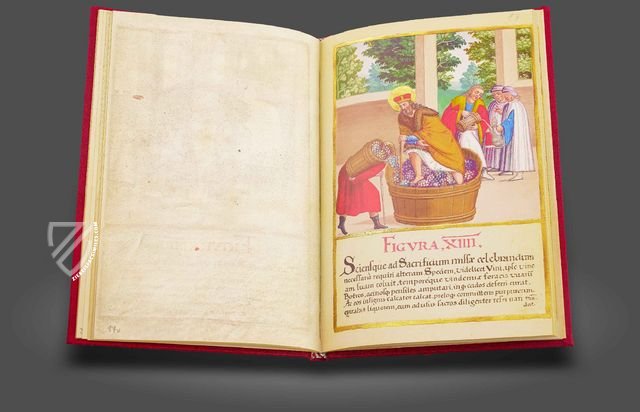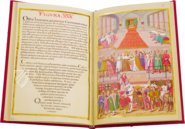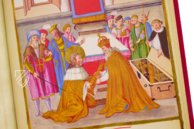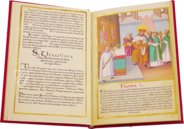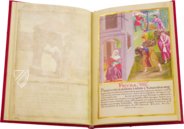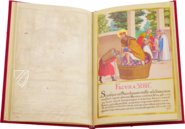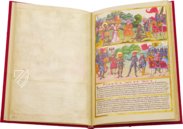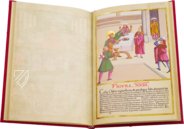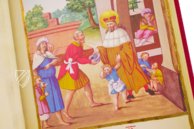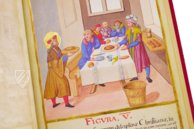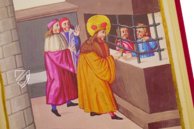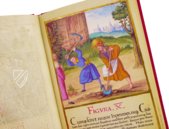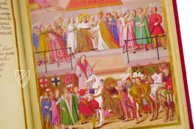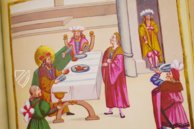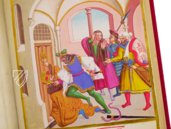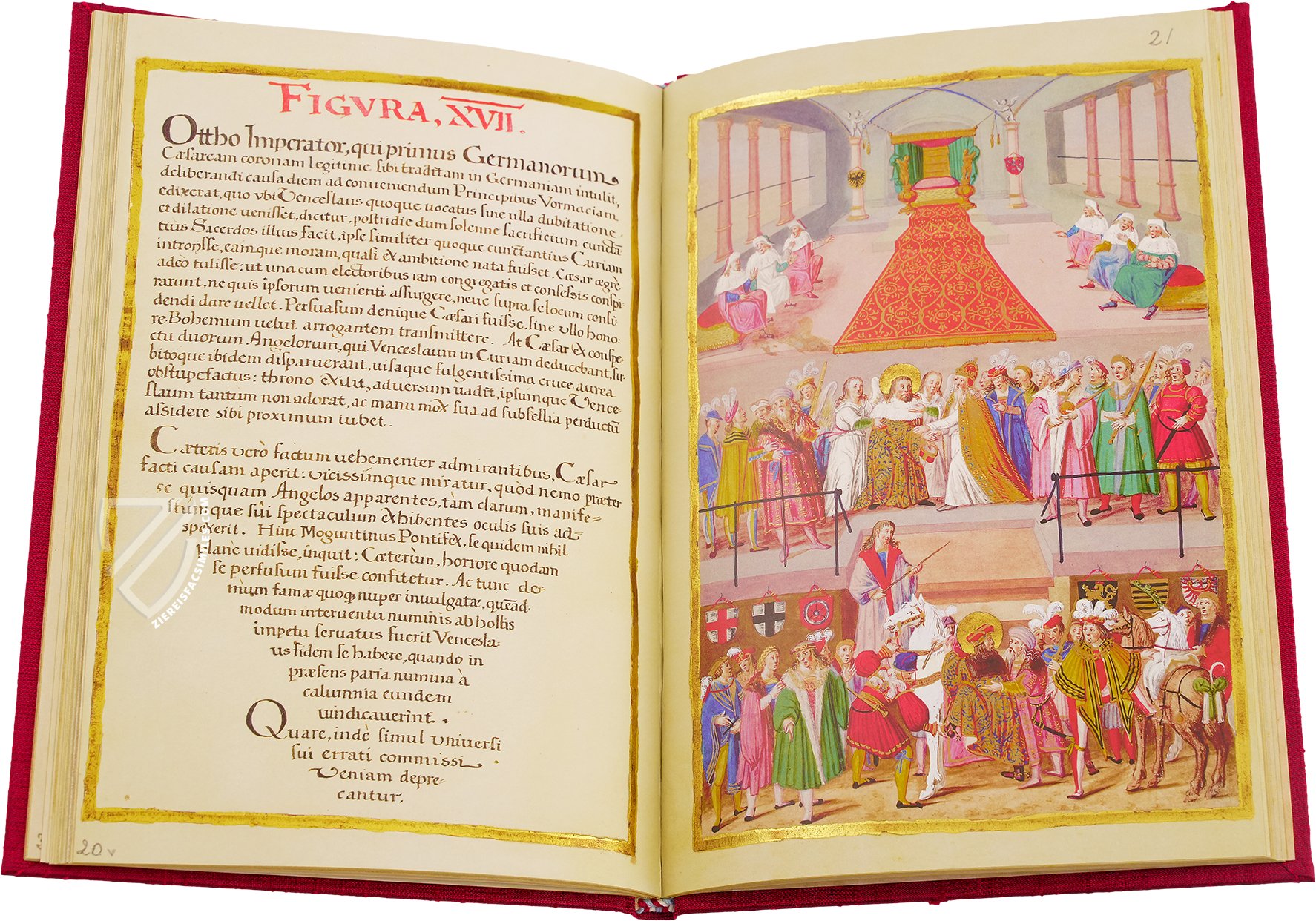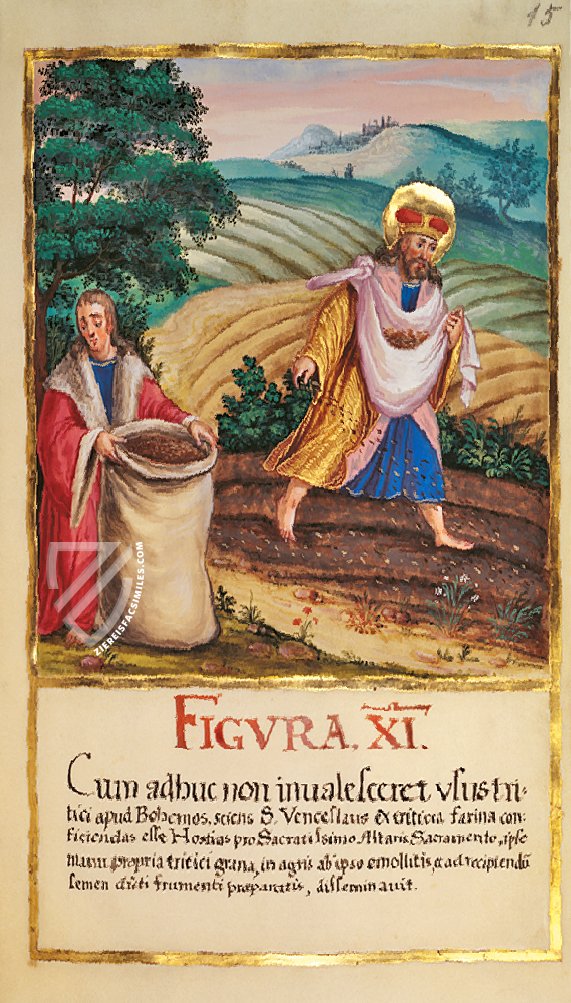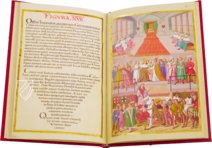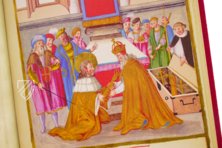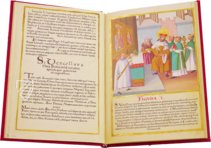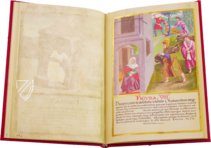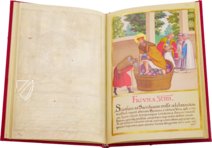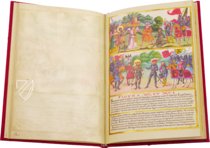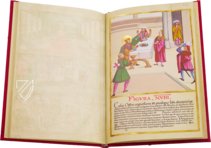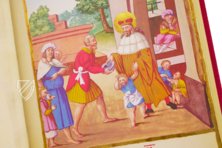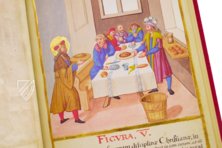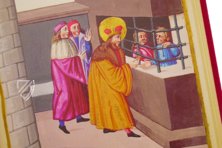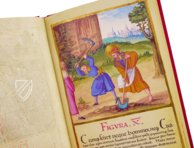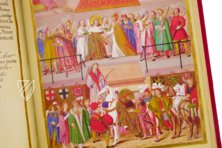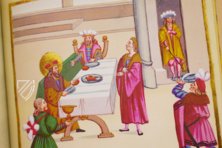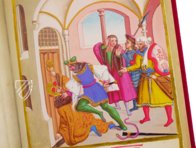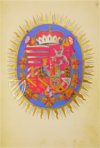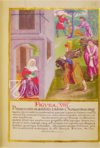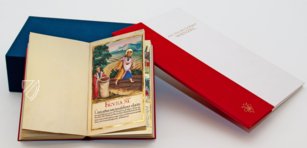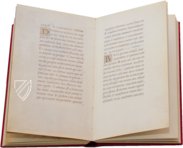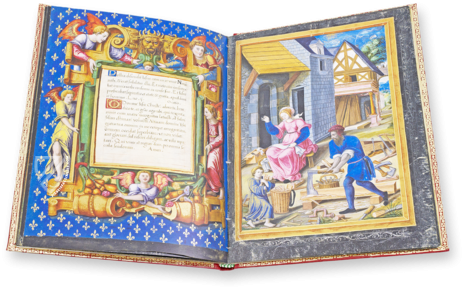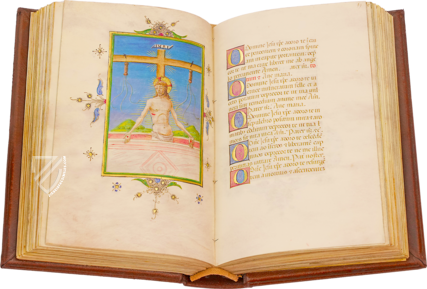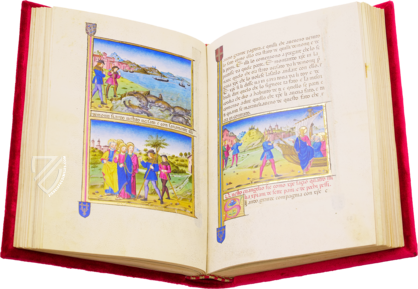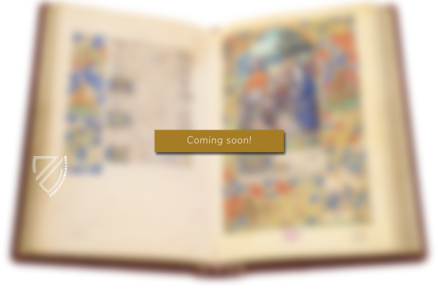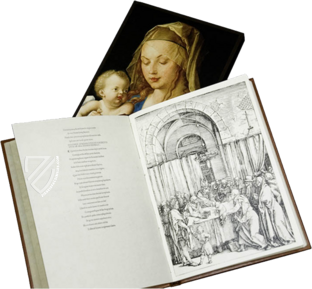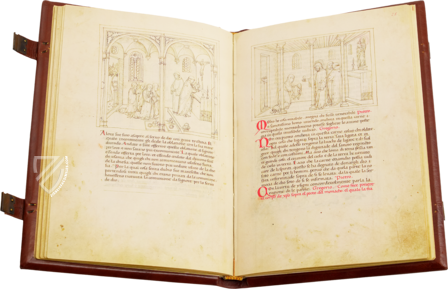Life of Saint Wenceslas
(1,000€ - 3,000€)
St. Wenceslas is one of the most important figures in Czech history, and the story of his life and death are indicative of a time of aggressive Christianization. After succeeding his mother Drahomíra as the sovereign ruler of Bohemia in 925, her anti-Christian measures were reversed and Prince Wenceslas set about making Christianity the state religion. Like their mother, his younger brother Boleslaw saw Christianity as a threat to their power and sovereignty and was covetous of his brother’s title. So it was that Wenceslas was martyred while on his way to morning prayers, murdered by his own brother in a plot that involved their mother. Wenceslas is now venerated as a saint and remembered every September 28th, and he is also commemorated in a splendid 16th century manuscript by the great Martin Hutský, a master painter from Prague.
Life of Saint Wenceslas
The triumphal march of Christianity had progressed greatly by the 10th century, but the extensive consequences of Christianization are still not known to us today. Since the only religious-seeming attitude of a ruling house lead inevitably to very worldly conflicts: in reality it was always about power, influence, and dependencies. St. Wenceslas is an ambassador for the devastating effects of Christianization in the then still small principality of Bohemia. He has lost none of his significance for Czechia today.
Resistance to the Christianization of Bohemia
Wenceslas of Bohemia was born ca. 908 and was the oldest son of his father Wratislav I and his wife Drahomíra. His father was a Christian. His mother, on the other hand, was not baptized, as was a large portion of the population of his principality. When Wratislav I died in 922, his mother Drahomíra assumed the reign for the still underage Wenceslas. Wenceslas was handed over to his very Christian grandmother Ludmilla and was educated to that effect. There naturally lay a high potential for conflict in this constellation: above all else, ** in Christianity, Drahomíra saw a loss of power** because Christianization would weaken the independence of the then small principality, in which they must bow to the kings of the Romans. In order to demonstrate her power and to make an example of the Bohemian Christians, Drahomíra took a drastic measure: she had her stepmother Ludmilla murdered and banished all missionaries. In this way, every external influence of a Christian monarch was to be hindered in the principality.
A New Christian Prince
Everything changed when Wenceslas came to power in the year 925. He provided for the return of the missionaries and with inter alia the construction of the so-called St. Veit’s Rotunda – over which the foundation walls of the famous St. Veit’s Cathedral today – made a clear sign to Christendom. Wenceslas' goal was the implementation of Christianity as the state religion within his realm. With his efforts, the young prince reversed the machinations of his mother. Now Boleslaw, the younger brother of Wenceslas, came into play: he too was suspicious of the new religion. To that effect, he wanted to take the place of his brother as sovereign, and so he forged a murder plot with his mother Drahomíra: he would be invited to Altbunzlau under the pretense of a family gathering, since Wenceslas was unassailable in Prague. On the way to morning prayers on September 28th in either 929 or 935, Wenceslas was killed by his brother and his henchmen in a struggle. Boleslaw achieved what he wanted. Nevertheless, he was not able to maintain the independence of his territory in the long run, even though he expanded and consolidated the position of Bohemia. Boleslaw had to submit to King Otto I in 950, and as a result the sought-after independence of the small principality could not be maintained.
Wenceslas the Saint
His brother Wenceslas already had a particular reputation as a Christian during his lifetime. Thus his grave has become a pilgrimage site, and Wenceslas was venerated as a saint shortly after his death. Miracles and cures are supposed to have occurred at his grave. The veneration of Wenceslas has remained unbroken since that time: Prague’s Wenceslas Plaza was used in recent history for special occasions and demonstrations, e.g. in the course of the so-called “Velvet Revolution” of 1989. Today, the 28th of September is solemnized as the official holiday of St. Wenceslas. Wenceslas is depicted as an exemplary Christian in his legends: he baptized children and saw personally to their Christian upbringing; soup kitchens and the freeing of prisoners demonstrate his brotherly love, the healing of the sick is supposed to indicate a particular proximity to God already during his lifetime. Historically documented military victories were justified in the legends by the appearance of angels. Wenceslas dispensed with the subjugation of his enemies. He left them with kind gestures and saw the true victory in the conversion of the opponents of Christianity.
The Manuscript
In 1585, Martin Hutský, Prague’s master of painting, dedicated this manuscript to his sponsor and patron Archduke Ferdinand II of Tyrol. The Archduke’s incredible, splendidly colored and designed escutcheon on fol. 1 introduces the manuscript. It is followed by a two-page dedication by Hutský to his patron. The historic life story of Wenceslas was written down before the legend with its miniatures. The legend of the saint is rendered on 23 pages as such: a thin gold strip forms the frame wherein image and text are interlinked, since what is depicted in the miniature is outlined underneath it. The artist not only designed the illumination, he also wrote the explanations in the manuscript himself.
Codicology
- Alternative Titles
- Life of Saint Wenceslas
Vita des heiligen Wenzel
Icones historici vitam et martyrium sancti Wenceslai principis Boemiae designantes - Size / Format
- 66 pages / 22.6 × 15.8 cm
- Origin
- Czech Republic
- Date
- 1585
- Epochs
- Style
- Genre
- Language
- Script
- Humanistic minuscule
- Illustrations
- 23 miniatures with gold
- Patron
- Archduke Ferdinand II of Austria (1529–95)
- Artist / School
- Martin Hutský
Life of Saint Wenceslas
The King Sowing Grain
King Wenceslas was famous for his generosity and many legends about him tell of how he cared for the welfare of his people, most famously in the Christmas carol “Good King Wenceslas”. The King is shown here helping to sew grain and although wearing his crown and dressed in beautiful robes, his piety is attested to by his simmering golden halo and bare feet. It is a wonderful and dynamic image with Saint Wenceslas in mid-stride as grain flies out of his hand.
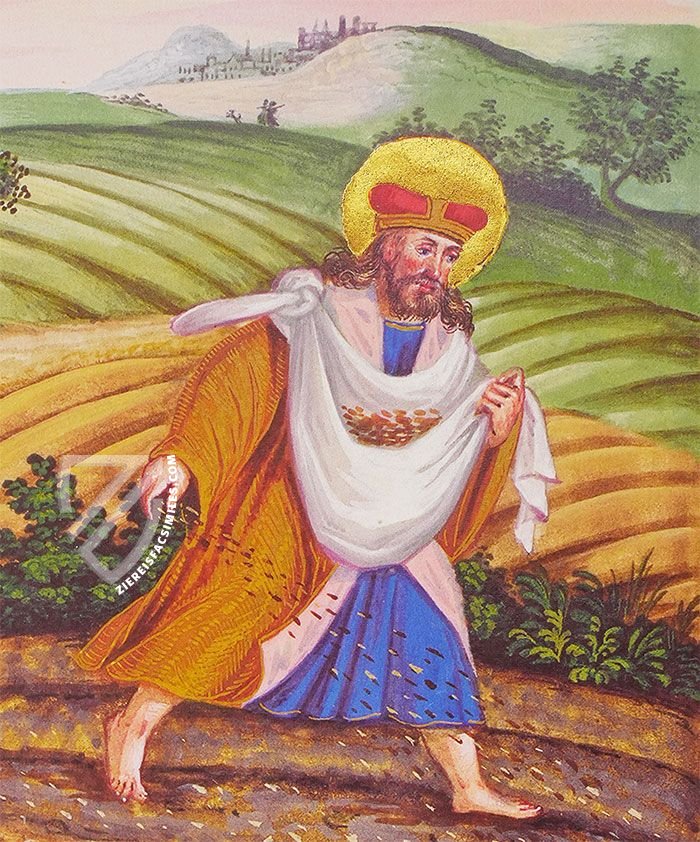
Life of Saint Wenceslas
Meeting of Wenceslas and Duke Radislaw von Kamim, Angel with Cross Prevents a Duel
According to legend, one of the vassals of King Wenceslas I, Duke Radislaw, rose in rebellion against his liege lord. Wenceslas attempted to resolve the conflict peacefully, which was taken as a sign of weakness by Radislaw, and so the two armies met on the battlefield. In one last attempt to avoid unnecessary bloodshed, Wenceslas challenged Radislaw to single combat, and the two met between the hosts.
As Radislaw approached Wenceslas, two angels appeared on either side of the King, one holding a cross and the other a flag, crying “stand off!”. Radislaw dropped to his knees and repented of his rebellion. Wenceslas raised him up and forgave him, welcoming him back into favor – an exemplary act of Christian mercy worthy of a saint.
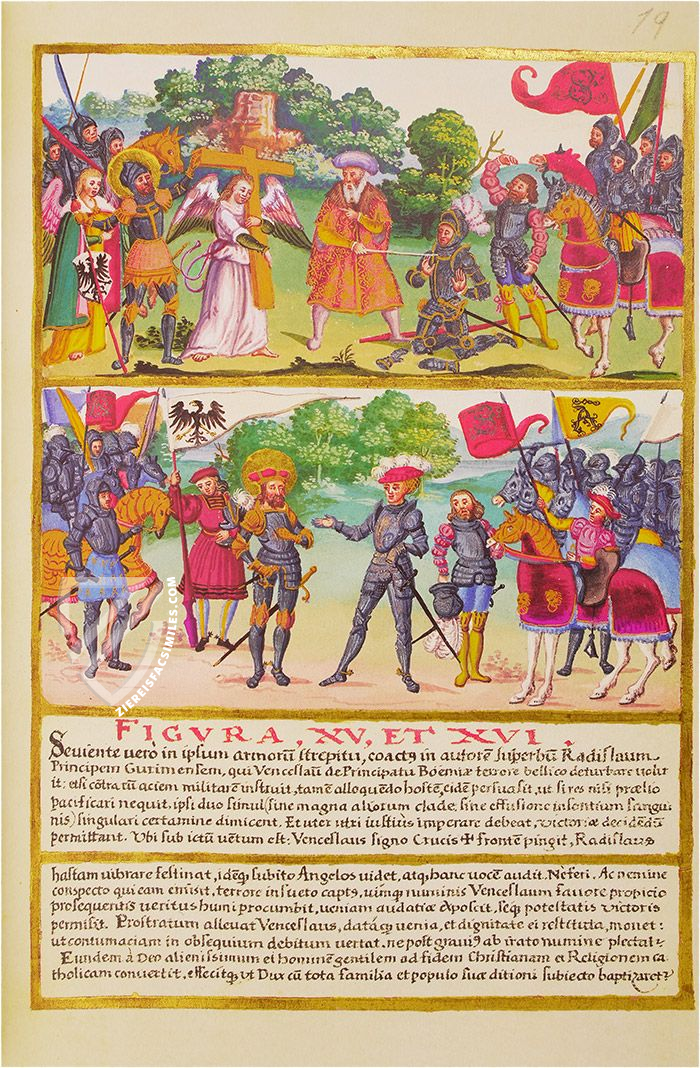
#1 Die Vita des heiligen Wenzel (Normal Edition)
Language: German
(1,000€ - 3,000€)
#2 Die Vita des heiligen Wenzel (Real Gold Edition)
Language: German
(3,000€ - 7,000€)
- Treatises / Secular Books
- Apocalypses / Beatus
- Astronomy / Astrology
- Bestiaries
- Bibles / Gospels
- Chronicles / History / Law
- Geography / Maps
- Saints' Lives
- Islam / Oriental
- Judaism / Hebrew
- Single Leaf Collections
- Leonardo da Vinci
- Literature / Poetry
- Liturgical Manuscripts
- Medicine / Botany / Alchemy
- Music
- Mythology / Prophecies
- Psalters
- Other Religious Books
- Games / Hunting
- Private Devotion Books
- Other Genres
- Afghanistan
- Armenia
- Austria
- Belgium
- Belize
- Bosnia and Herzegovina
- China
- Colombia
- Costa Rica
- Croatia
- Cyprus
- Czech Republic
- Denmark
- Egypt
- El Salvador
- Ethiopia
- France
- Germany
- Greece
- Guatemala
- Honduras
- Hungary
- India
- Iran
- Iraq
- Israel
- Italy
- Japan
- Jordan
- Kazakhstan
- Kyrgyzstan
- Lebanon
- Liechtenstein
- Luxembourg
- Mexico
- Morocco
- Netherlands
- Palestine
- Panama
- Peru
- Poland
- Portugal
- Romania
- Russia
- Serbia
- Spain
- Sri Lanka
- Sweden
- Switzerland
- Syria
- Tajikistan
- Turkey
- Turkmenistan
- Ukraine
- United Kingdom
- United States
- Uzbekistan
- Vatican City
- A. Oosthoek, van Holkema & Warendorf
- Aboca Museum
- Ajuntament de Valencia
- Akademie Verlag
- Akademische Druck- u. Verlagsanstalt (ADEVA)
- Aldo Ausilio Editore - Bottega d’Erasmo
- Alecto Historical Editions
- Alkuin Verlag
- Almqvist & Wiksell
- Amilcare Pizzi
- Andreas & Andreas Verlagsbuchhandlung
- Archa 90
- Archiv Verlag
- Archivi Edizioni
- Arnold Verlag
- ARS
- Ars Magna
- ArtCodex
- AyN Ediciones
- Azimuth Editions
- Badenia Verlag
- Bärenreiter-Verlag
- Belser Verlag
- Belser Verlag / WK Wertkontor
- Benziger Verlag
- Bernardinum Wydawnictwo
- BiblioGemma
- Biblioteca Apostolica Vaticana (Vaticanstadt, Vaticanstadt)
- Bibliotheca Palatina Faksimile Verlag
- Bibliotheca Rara
- Boydell & Brewer
- Bramante Edizioni
- Bredius Genootschap
- Brepols Publishers
- British Library
- C. Weckesser
- Caixa Catalunya
- Canesi
- CAPSA, Ars Scriptoria
- Caratzas Brothers, Publishers
- Carus Verlag
- Casamassima Libri
- Centrum Cartographie Verlag GmbH
- Chavane Verlag
- Christian Brandstätter Verlag
- Circulo Cientifico
- Club Bibliófilo Versol
- Club du Livre
- CM Editores
- Collegium Graphicum
- Collezione Apocrifa Da Vinci
- Comissão Nacional para as Comemorações dos Descobrimentos Portugueses
- Coron Verlag
- Corvina
- CTHS
- D. S. Brewer
- Damon
- De Agostini/UTET
- De Nederlandsche Boekhandel
- De Schutter
- Deuschle & Stemmle
- Deutscher Verlag für Kunstwissenschaft
- DIAMM
- Droz
- E. Schreiber Graphische Kunstanstalten
- Ediciones Boreal
- Ediciones Grial
- Ediclube
- Edições Inapa
- Edilan
- Editalia
- Edition Deuschle
- Edition Georg Popp
- Edition Leipzig
- Edition Libri Illustri
- Editiones Reales Sitios S. L.
- Éditions de l'Oiseau Lyre
- Editions Medicina Rara
- Editorial Casariego
- Editorial Mintzoa
- Editrice Antenore
- Editrice Velar
- Edizioni Edison
- Egeria, S.L.
- Eikon Editores
- Electa
- Emery Walker Limited
- Enciclopèdia Catalana
- Eos-Verlag
- Ephesus Publishing
- Ernst Battenberg
- Eugrammia Press
- Extraordinary Editions
- Fackelverlag
- Facsimila Art & Edition
- Facsimile Editions Ltd.
- Facsimilia Art & Edition Ebert KG
- Faksimile Verlag
- Feuermann Verlag
- Folger Shakespeare Library
- Franco Cosimo Panini Editore
- Friedrich Wittig Verlag
- Fundación Hullera Vasco-Leonesa
- G. Braziller
- Gabriele Mazzotta Editore
- Gebr. Mann Verlag
- Gesellschaft für graphische Industrie
- Getty Research Institute
- Giovanni Domenico de Rossi
- Giunti Editore
- Graffiti
- Grafica European Center of Fine Arts
- Guido Pressler
- Guillermo Blazquez
- Gustav Kiepenheuer
- H. N. Abrams
- Harrassowitz
- Harvard University Press
- Helikon
- Hendrickson Publishers
- Henning Oppermann
- Herder Verlag
- Hes & De Graaf Publishers
- Hoepli
- Holbein-Verlag
- Houghton Library
- Hugo Schmidt Verlag
- Idion Verlag
- Il Bulino, edizioni d'arte
- ILte
- Imago
- Insel Verlag
- Insel-Verlag Anton Kippenberger
- Instituto de Estudios Altoaragoneses
- Instituto Nacional de Antropología e Historia
- Introligatornia Budnik Jerzy
- Istituto dell'Enciclopedia Italiana - Treccani
- Istituto Ellenico di Studi Bizantini e Postbizantini
- Istituto Geografico De Agostini
- Istituto Poligrafico e Zecca dello Stato
- Italarte Art Establishments
- Jan Thorbecke Verlag
- Johnson Reprint Corporation
- Josef Stocker
- Josef Stocker-Schmid
- Jugoslavija
- Karl W. Hiersemann
- Kasper Straube
- Kaydeda Ediciones
- Kindler Verlag / Coron Verlag
- Kodansha International Ltd.
- Konrad Kölbl Verlag
- Kurt Wolff Verlag
- La Liberia dello Stato
- La Linea Editrice
- La Meta Editore
- Lambert Schneider
- Landeskreditbank Baden-Württemberg
- Leo S. Olschki
- Les Incunables
- Liber Artis
- Library of Congress
- Libreria Musicale Italiana
- Lichtdruck
- Lito Immagine Editore
- Lumen Artis
- Lund Humphries
- M. Moleiro Editor
- Maison des Sciences de l'homme et de la société de Poitiers
- Manuscriptum
- Martinus Nijhoff
- Maruzen-Yushodo Co. Ltd.
- MASA
- Massada Publishers
- McGraw-Hill
- Metropolitan Museum of Art
- Militos
- Millennium Liber
- Müller & Schindler
- Nahar - Stavit
- Nahar and Steimatzky
- National Library of Wales
- Neri Pozza
- Nova Charta
- Oceanum Verlag
- Odeon
- Orbis Mediaevalis
- Orbis Pictus
- Österreichische Staatsdruckerei
- Oxford University Press
- Pageant Books
- Parzellers Buchverlag
- Patrimonio Ediciones
- Pattloch Verlag
- PIAF
- Pieper Verlag
- Plon-Nourrit et cie
- Poligrafiche Bolis
- Presses Universitaires de Strasbourg
- Prestel Verlag
- Princeton University Press
- Prisma Verlag
- Priuli & Verlucca, editori
- Pro Sport Verlag
- Propyläen Verlag
- Pytheas Books
- Quaternio Verlag Luzern
- Reales Sitios
- Recht-Verlag
- Reichert Verlag
- Reichsdruckerei
- Reprint Verlag
- Riehn & Reusch
- Roberto Vattori Editore
- Rosenkilde and Bagger
- Roxburghe Club
- Salerno Editrice
- Saltellus Press
- Sandoz
- Sarajevo Svjetlost
- Schöck ArtPrint Kft.
- Schulsinger Brothers
- Scolar Press
- Scrinium
- Scripta Maneant
- Scriptorium
- Shazar
- Siloé, arte y bibliofilia
- SISMEL - Edizioni del Galluzzo
- Sociedad Mexicana de Antropología
- Société des Bibliophiles & Iconophiles de Belgique
- Soncin Publishing
- Sorli Ediciones
- Stainer and Bell
- Studer
- Styria Verlag
- Sumptibus Pragopress
- Szegedi Tudomànyegyetem
- Taberna Libraria
- Tarshish Books
- Taschen
- Tempus Libri
- Testimonio Compañía Editorial
- Thames and Hudson
- The Clear Vue Publishing Partnership Limited
- The Facsimile Codex
- The Folio Society
- The Marquess of Normanby
- The Richard III and Yorkist History Trust
- Tip.Le.Co
- TouchArt
- TREC Publishing House
- TRI Publishing Co.
- Trident Editore
- Tuliba Collection
- Typis Regiae Officinae Polygraphicae
- Union Verlag Berlin
- Universidad de Granada
- University of California Press
- University of Chicago Press
- Urs Graf
- Vallecchi
- Van Wijnen
- VCH, Acta Humaniora
- VDI Verlag
- VEB Deutscher Verlag für Musik
- Verlag Anton Pustet / Andreas Verlag
- Verlag Bibliophile Drucke Josef Stocker
- Verlag der Münchner Drucke
- Verlag für Regionalgeschichte
- Verlag Styria
- Vicent Garcia Editores
- W. Turnowski Ltd.
- W. Turnowsky
- Waanders Printers
- Wiener Mechitharisten-Congregation (Wien, Österreich)
- Wissenschaftliche Buchgesellschaft
- Wissenschaftliche Verlagsgesellschaft
- Wydawnictwo Dolnoslaskie
- Xuntanza Editorial
- Zakład Narodowy
- Zollikofer AG

